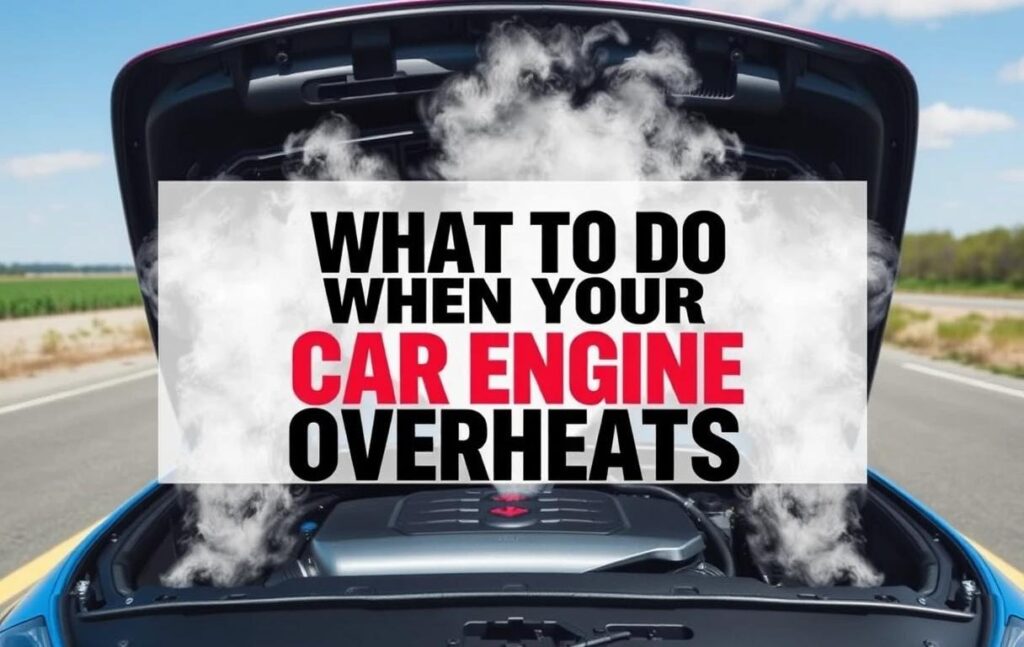Introduction:
Experiencing an engine overheating can be a stressful situation for any car owner. When the engine temperature rises beyond the safe limits, it can cause long-term damage if not dealt with promptly. The good news is, by understanding the causes and knowing the right steps to take, you can prevent further damage and ensure the longevity of your vehicle. In this blog, we will explore what causes engine overheating, how to handle it in the moment, and preventative measures to avoid it in the future.

Table of Contents
Why Does an Engine Overheat?
Before we dive into the steps to take during an overheated engine, it’s essential to understand why it happens. An engine is designed to operate within a specific temperature range, typically between 195°F to 220°F (90°C to 105°C). However, several factors can cause an engine to overheat:
- Low Coolant Levels: The coolant absorbs heat from the engine and regulates its temperature. If the coolant is low, it cannot efficiently cool the engine.
- Faulty Thermostat: The thermostat regulates coolant flow. If it gets stuck in the closed position, it can prevent coolant from circulating, causing the engine to overheat.
- Radiator Issues: If the radiator is clogged, leaking, or damaged, it cannot dissipate heat properly.
- Broken Water Pump: The water pump circulates coolant throughout the engine. If it fails, the coolant won’t circulate, and the engine will overheat.
- Faulty Fan or Belt: A malfunctioning fan or broken serpentine belt can lead to poor cooling of the engine.
- Low Oil Levels: Insufficient oil levels increase friction, which generates excessive heat in the engine.
What to Do When Your Engine Overheats?
If you notice that your car’s engine temperature gauge is rising or the temperature warning light is on, it’s essential to act quickly. Here’s a step-by-step guide on what to do if your engine overheats.
1. Turn Off the Air Conditioner and Turn On the Heater
As soon as you notice that the engine is overheating, the first thing you should do is turn off the air conditioner (AC) and turn on the heater to its maximum setting. This may seem counterintuitive, but the heater will redirect some of the engine’s heat into the cabin, which can help cool down the engine temporarily. While uncomfortable, this can provide enough time to get your vehicle to a safe spot.
- Why It Works: The heater works by transferring heat from the engine into the car’s cabin. This can lower the engine’s temperature by diverting some of the heat that would otherwise stay in the engine.
2. Pull Over Safely
If your engine is overheating, it’s essential to stop the car as soon as possible. Continuing to drive with an overheated engine can cause severe damage, such as warped cylinder heads or a cracked engine block.
- Find a Safe Location: Pull over to the side of the road or into a parking lot, away from traffic. Turn on your hazard lights to alert other drivers that you’re experiencing an issue.
- Shut Off the Engine: Once you’ve safely stopped, turn off the engine immediately. Allowing it to run any longer could cause permanent damage to the components.
3. Wait for the Engine to Cool Down
After turning off the engine, give it time to cool down before attempting to open the hood. Never attempt to open the radiator cap or coolant reservoir cap while the engine is still hot, as the escaping steam or hot coolant could burn you.
- Cooling Time: Wait at least 15 to 30 minutes, depending on how hot the engine is. You can use this time to assess the situation and ensure it’s safe to proceed.
4. Check Coolant Levels
Once the engine has cooled sufficiently, pop the hood and check the coolant level in the reservoir. If the coolant level is low, it could be a major cause of overheating.
- Add Coolant if Needed: If you have coolant (or water in an emergency), add it to the reservoir. If you don’t have coolant on hand, avoid driving the car until you’ve addressed the issue properly.
- Be Cautious: If the coolant reservoir is empty, it’s possible that you have a leak in the system. Adding coolant won’t be a permanent solution, and you’ll need to have the system repaired as soon as possible.
5. Inspect the Radiator and Hoses
After checking the coolant, inspect the radiator and hoses for any signs of damage or leakage. Look for puddles of coolant under the car or visible cracks in the radiator or hoses.
- Look for Leaks: A leak in the radiator or hoses can cause a loss of coolant, leading to overheating. If you notice any leaks, you should avoid driving the car further and get it towed to a mechanic.
6. Check the Fan and Belt
If the engine overheats again, it could be due to an issue with the radiator fan or serpentine belt. The fan helps cool the engine by pushing air through the radiator, and the belt drives various engine components, including the water pump.
- Test the Fan: Start the engine and see if the radiator fan is running. If it’s not, it may be a sign of a faulty fan motor or electrical issue.
- Check the Serpentine Belt: Ensure that the belt is intact and hasn’t slipped off. If the belt is broken or loose, it can prevent the water pump from circulating coolant properly.
7. Call for Roadside Assistance or Tow the Car
If you are unable to find the cause of the overheating or cannot fix the issue, it’s best to call for roadside assistance or tow the car to a trusted mechanic. Driving an overheated car can cause severe internal damage that may be costly to repair.
- Professional Help: A mechanic can perform a thorough inspection of the engine, radiator, water pump, thermostat, and cooling system to identify the exact cause of the overheating.
Preventing Future Overheating
While it’s essential to know what to do in the event of an overheated engine, prevention is always better than cure. Here are some tips to prevent engine overheating in the future:
- Regular Maintenance: Schedule regular maintenance for your car, including coolant checks, radiator inspections, and oil changes.
- Monitor Coolant Levels: Check the coolant level regularly to ensure it’s at the proper level.
- Replace Worn-out Parts: If your car’s radiator fan, thermostat, or water pump is old or worn out, consider replacing them before they fail.
- Drive Carefully: Avoid overloading your car, driving in extreme conditions, or pushing the engine too hard, as these can all contribute to overheating.
Conclusion
An overheating engine is a serious issue that requires immediate attention. By following the steps outlined above, you can reduce the risk of long-term damage to your engine and ensure that you stay safe on the road. Remember to always allow the engine to cool down before attempting any repairs, and if necessary, seek professional help to address any underlying issues. With proper care and attention, your vehicle’s engine will continue running smoothly for years to come.
FAQs
1. Why is my car engine overheating?
Engine overheating can be caused by low coolant levels, a faulty thermostat, radiator issues, or a broken water pump.
2. What should I do if my car engine overheats?
Turn off the air conditioner, pull over safely, let the engine cool down, and check coolant levels.
3. Can driving with an overheated engine cause damage?
Yes, continuing to drive can cause severe engine damage, such as a cracked engine block or warped cylinder heads.
4. How can I prevent my engine from overheating?
Regular maintenance, checking coolant levels, and replacing worn parts can help prevent engine overheating.
5. it safe to drive after adding coolant to the engine?
It’s safe only if the leak is fixed and the coolant level is sufficient. Otherwise, avoid driving until repairs are made.



